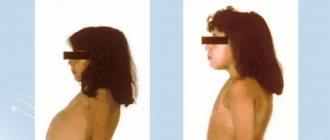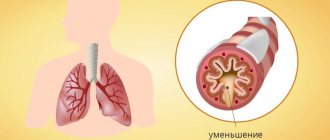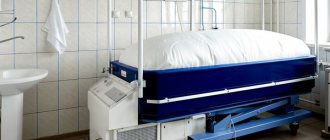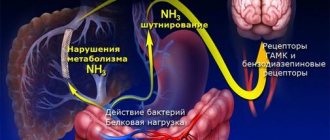"Gifts of Nature" - to Man
There is nothing superfluous or ill-considered in nature. The human body is also a part of nature, so an increase in body temperature is not just an unpleasant sensation, which we often try to get rid of by taking medications, but a signal of a problem in the system and at the same time a defensive reaction. It is a nonspecific coordinated response to disease. When a “stranger” invades (be it bacteria, viruses, protozoa or non-microbial foreign substances - antigens), the blood cells responsible for our immunity - leukocytes - are activated. This "army" of defenders consists of "units", each of which performs its own task. Lymphocytes, monocytes, neutrophils, eosinophils enter into the fight and secrete a special substance - leukocyte or endogenous pyrogen. When this substance acts on the thermoregulation center located in the brain, namely, in the anterior hypothalamus, body temperature rises. Against this background, numerous body defense mechanisms are activated: the phagocytic activity of macrophages increases, the production of interferons and antibodies increases. This is the so-called “pyrogenic” mechanism for increasing body temperature. This is why doctors do not recommend lowering body temperature without good reason.
Symptoms
With a slight increase in temperature, a person does not feel any discomfort and continues to lead his usual lifestyle. Rarely, there may be a feeling of discomfort due to temperature differences and a feeling of heaviness in the head area. When the temperature rises to 38.0 °C or more, characteristic “feverish” symptoms appear:
- redness of the skin of the face and body;
- inflamed eyes, caused by increased tear production;
- intense sweating associated with the body’s attempt to reduce the increased temperature;
- headache;
- aches in muscles and joints;
- decreased appetite;
- rapid breathing;
- drowsiness, immobility.
Children may experience a different course of the febrile process. “Red” fever is characterized by a slight deterioration in the condition, maintaining a comfortable temperature of the extremities and relatively stable health. With “white” fever, the child becomes lethargic, his skin turns pale and acquires a bluish tint, the pulse becomes faster, and blood pressure is higher.
When the temperature creeps up
The cause of an increase in body temperature is not always an infectious disease. Tumor cells are also capable of producing endogenous pyrogen, which is most often the cause of fever, rather than the inflammation or decay that accompanies the tumor process. In the case of the non-infectious nature of the disease and the occurrence of aseptic inflammation during mechanical and chemical damage, leukocytes also migrate to the site of damage and produce endogenous pyrogen. In all cases, the mechanism for increasing body temperature is the same. When the diagnosis is clear, the underlying disease is treated and the problem of increased body temperature is resolved simply: the disease has disappeared - body temperature has returned to normal. In these situations, normalization of body temperature is a criterion for recovery.
Principles of thermometry
The most accurate measurement of body temperature is possible only by recording the core temperature, i.e. temperature of deep tissues. Mercury thermometers and axillary temperature measurements allow you to record the temperature of superficial tissues. Recording body temperature with their help takes time, sterilization is required after each use, and they are dangerous for restless children. Mercury thermometers can be used to monitor the readings of electronic thermometers.
Measuring body temperature using liquid crystal strips applied to the forehead allows you to obtain readings only from superficial structures. The measurement accuracy is low: in some cases it is not possible to record a moderate increase in temperature. The temperature in the oral cavity is much closer to the true temperature of the deep parts of the body. But measuring oral temperature requires the child to remain calm. The temperature in the rectum almost completely corresponds to the temperature of the core. However, children react negatively to this procedure; the presence of feces in the rectum affects the accuracy of measurements.
The gold standard is measuring temperature with a tympanic thermometer, which detects infrared radiation from the eardrum. The accuracy of measurements corresponds to rectal ones, but the procedure lasts no more than 2 s and does not require the child’s cooperation [3, 4].
Fever percentage
Things are more complicated when doctors are faced with a disease called “fever of unknown origin” (FOU). Unlike a simple increase in body temperature, fever is characterized by disruption of all body systems. You may experience rapid heartbeat, profuse sweating, joint and muscle pain, headaches, lack of appetite, and increased blood pressure. We can talk about LNG when fever is the main or only sign of the disease, body temperature reaches 38 degrees Celsius or higher, lasts for three or more weeks, and the diagnosis remains unclear even after a week-long examination using routine (generally accepted ) methods. Doctors have to deal with a variety of pathologies, which may initially be designated as LNG. With a more detailed examination, up to 50% of cases are due to infectious and inflammatory processes; 20-30% - on tumors; a pathology difficult to diagnose, united under the name “systemic connective tissue lesions” ranges from 10% to 20%; another 10-20% falls on diseases of various origins; and the share of undeciphered fevers remains 5-10%.
Principles of interpretation of measurement and examination results, risk groups
In case of infectious diseases, it does not allow even untreated body temperature to rise above 41.1 °C. Hyperthermic brain damage does not develop at temperatures below 41.7 °C. There is no reliable connection between serious bacterial infections and the level of fever until it exceeds 40 °C. Teething never results in hyperthermia above 38.4°C.
Febrile seizures occur in 4% of children with high fevers and in 3% of previously healthy children over the age of 6 months. up to 6 years old. The faster the temperature rises, the higher the likelihood of febrile seizures. Repeated febrile seizures during the same episode of the disease are recorded in 10–15% of children. 40% of children later develop relapses of febrile seizures under similar conditions. The earlier the seizure episode, the more likely it is to recur. With the first episode of febrile seizures before the age of 1 year, they recur in 50% of cases, with the first episode at the age of 2 years - in 30%. Frequently ill children with high hyperthermia during each episode of illness, children with concomitant or chronic diseases are predisposed to febrile convulsions. If one of the parents had febrile seizures in childhood, the risk of seizures in the child increases by 10-20%. If 2 parents and 1 of their children had febrile seizures in childhood, the likelihood of seizures in the other child increases by 30-40%.
The likelihood of afebrile seizures (epilepsy) in the future is high if there is a family history of epilepsy, neuropsychological development disorders, craniofacial anomalies, atypical febrile seizures (long-term, focal), an episode of febrile seizures at a temperature below 39 ° C.
Among febrile children, the high-risk group [4] with a high probability of developing life-threatening conditions includes children:
- less than 3 months of age;
- with a fever of more than 40 °C (more than 38 °C for children in the first 3 months of life);
- with signs of “white” fever;
- with severe general condition;
- with a history of severe hypoxia during childbirth, prematurity, head injury and/or seizures; an episode of seizures;
— with cardiovascular or respiratory failure, stage II;
- with dehydration;
- with incessant screaming, screaming at the slightest movement or touch;
- if the child is sleeping and it is difficult to wake him up;
- with purple spots on the skin;
- with stiff neck;
- with tension of the large fontanelle;
- if the child is unable to swallow, saliva comes out of the mouth;
- if breathing is difficult and does not improve after clearing the nasal passages;
- with a high temperature that persists for more than a day.
The low-risk group [8] includes the following children, incl. early age:
- general good condition of the child; appetite is preserved, sleep is not disturbed;
- the child was born full-term;
— antimicrobial therapy was not carried out during the perinatal period;
— there was no hyperbilirubinemia;
- the child was discharged from the maternity hospital at the same time as the mother;
- the child has not been previously hospitalized;
— antibiotic therapy has not been previously administered;
— no chronic or concomitant diseases; no infections of the ear, skin, soft tissues, bones, joints;
— in blood tests, the number of leukocytes is 5000–20,000/mm3; in urine tests, the number of leukocytes is no more than 10 per field of view;
- in stool tests in children with diarrhea, the number of leukocytes is no more than 5 in the field of view.
However, even if the child’s condition is apparently good, the pediatrician must always remember the likelihood of unfavorable dynamics. Thus, at least 10% of children in the first 3 months of life with a fever above 38 °C and an initially favorable condition later manifest severe bacterial infections, including meningitis [9, 10].
There is a person, but there is no diagnosis?
It is in the latter case that the diagnosis remains as LNG. This is the official term, and it is included in the ICD-10 (International Classification of Diseases, Tenth Revision), so the doctor who made such a diagnosis based on the results of the examination is often, to the patient’s displeasure, absolutely right. It makes more sense to leave the patient under dynamic observation than to treat him for invented chronic bronchitis or pyelonephritis, often completely unsuccessfully, or even to the detriment of the patient. LNG entails a number of problems: unclear diagnosis and, as a consequence, delay of treatment for an indefinite period, length of hospital stay, a large (often expensive) volume of examinations, and loss of patient confidence in the doctor.
Treatment options for fever
Stabilization of body temperature and treatment of fever is carried out using the following methods:
- Taking antipyretic medications. This could be paracetamol, aspirin (contraindicated in children under 12 years of age), ibuprofen tablets or syrup. The advantages of the liquid composition are the possibility of its precise dosage and ease of swallowing, which is especially important for children. It is possible to take powders containing the listed antipyretic substances, which simultaneously have an analgesic and anti-inflammatory effect.
- Compliance with bed rest, due to which the patient’s condition improves somewhat.
- Reviewing your diet in favor of frequent small meals. Priority is given to dishes with a liquid or puree consistency, the digestion of which causes the body to spend less energy. You should completely exclude the use of hot and spicy dishes, seasonings and salty foods that draw water from the body.
- Drink plenty of fluids to prevent dehydration.
- Taking medications to treat the underlying cause of the fever. These could be antibiotics, non-steroidal anti-inflammatory drugs, etc.
If the temperature rises after heat stroke, measures should be taken to reduce it. For this, the patient is wiped with cool water, given plenty of clean water to drink, covered with ice packs and wrapped in wraps.
Shaking, chilling, pounding... Whose fault?
Let's look in more detail at the causes of LNG. Infectious-inflammatory diseases are the largest section, which includes, in addition to infectious diseases themselves, caused by bacteria, viruses, protozoa, fungi, and purulent-inflammatory diseases of internal organs, such as abdominal abscesses, kidney diseases, and biliary tract diseases. Many infectious diseases today behave differently than they did decades ago. In the age of antibiotics and a changed ecology, microorganisms are also modified, adapting to new conditions. Tuberculosis is again relevant, which does not occur with changes in the lungs, but affects other internal organs, bones, lymph nodes, often manifested only by prolonged fever. A once forgotten disease, malaria, reappeared with fever. Only fever can manifest viral diseases - herpes, mononucleosis (Epstein-Barr virus), hepatitis B and C, human immunodeficiency virus. Due to the increased activity of ixodid ticks, Lyme disease, caused by Borrelia, which is transmitted by a tick bite, has become more frequent. Among tumors, fevers most often manifest as blood diseases or hemoblastoses, in particular, lymphoproliferative diseases (lymphogranulomatosis, lymphosarcoma), however, tumors of various organs can be accompanied by fever. Systemic connective tissue diseases (systemic lupus erythematosus, rheumatoid arthritis, systemic vasculitis and others) are a large group of diseases in which the process can begin with fever. In these cases, long-term follow-up and repeated laboratory examinations are often required. Other pathologies include diseases of the intestines, lungs, liver, thyroid gland, blood vessels of various etiologies, as well as allergic diseases, including drug fevers that occur in response to taking various drugs. In addition, there is a group of hereditary diseases that manifest themselves in adulthood with fever.
Fever of unknown origin: causes
Fever is the body's response to illness. It can be considered as the earliest clinical manifestation of a wide range of diseases of various natures. The latter seriously complicates diagnosis and requires complex diagnostics. An increase in temperature for a period of less than seven days is often a sign of infectious processes, and more than seven days is a sign of much more serious diseases. There are often cases when the cause of fever cannot be determined, but it also happens that it is an atypical form of a common illness.
| Possible causes of LNG | Pathological conditions |
| Infections and inflammation | They can be local and generalized, they account for up to half of all detection cases. These include:
|
| Neoplasms of malignant etiology | They account for about a third of all cases. These include:
|
| Systemic inflammatory pathologies of connective tissue | Their share does not exceed 20%. These include:
|
| Other pathological conditions | They cover a proportion of ten to twenty percent and may involve metabolic disorders, congenital diseases transmitted by inheritance, and fevers of a psychogenic nature. |
| Pathologies that cannot be diagnosed | Their share is about 10%, and they themselves consist of tumor formations of malignant etiology, as well as increases in temperature after taking antibacterial drugs. |
Diagnosis with test tube and microscope
The problem of LNG affects many areas of medicine and requires the attention of doctors of various specialties. And since the mechanism for increasing body temperature in the vast majority of cases is the same (we will not discuss vague subfebrile conditions, when the body temperature rises no higher than 380C for a long time and in most cases is a consequence of autonomic dysfunction or organic brain damage), then significant difficulties arise in the differential diagnosis of diseases. Selective rather than total screening is recommended. And only an experienced doctor can determine the required scope of examination after analyzing complaints, medical history, and examination results. The specialist will pay attention to paraneoplastic signs, that is, symptoms that may accompany the tumor process - specific changes in the skin, joints, blood vessels (migratory thrombophlebitis). In modern practice, the possibilities of laboratory methods are used - blood testing for specific tumor markers. To clarify the diagnosis, if infectious diseases are suspected, in addition to routine methods, serological and bacteriological tests of blood, urine, feces, and the polymerase chain reaction (PCR) method, which has 100% specificity, are used. To confirm the diagnosis of systemic connective tissue disease, repeated additional laboratory examinations (rheumatoid factor, antibodies to DNA, etc.) may be required. And in order to confirm the syndrome of autonomic dysfunction, that is, functional changes with unclear low-grade fevers, it is also necessary to conduct an examination to exclude a more serious pathology. The issue of treatment for LNG is decided individually in each specific case. In the meantime, the diagnosis is unclear, you should refrain from treatment. Only in cases of poor tolerance and possible complications (in the elderly, children and with concomitant pathologies) are drugs used to reduce body temperature, preferably paracetamol in appropriate doses.
Publications in the media
Fever of unknown origin (FOU) is an increase in body temperature >38.3 °C for >3 weeks without identifying the cause after a 1-week intensive diagnostic search.
Etiology • Infectious diseases . Any infection can be accompanied by fever, but difficulties in diagnosis are often caused by sporadic, uncharacteristic or atypical diseases. Anamnesis, including epidemiological, is important.
•• Bacterial infections ••• Abdominal abscesses (subphrenic, retroperitoneal, pelvic), the likelihood of which increases with a history of trauma, surgery, gynecological or laparoscopic manipulations ••• Tuberculosis is one of the common causes of LNG. Diagnosis is difficult in cases of extrapulmonary tuberculosis with negative tuberculin tests. An important role in diagnosis is assigned to the search for lymph nodes and their biopsy ••• Infectious endocarditis is difficult to diagnose in cases of absence of heart murmurs or negative bacteriological blood cultures (usually due to previous antibiotic therapy) ••• Empyema of the gallbladder or cholangitis in elderly patients may occur without local symptoms of tension in the right upper quadrant of the abdomen ••• Osteomyelitis can be suspected in the presence of local tenderness in the bones, but radiographic changes may not be detected until several weeks later ••• Meningeal or, especially, gonococcal sepsis can be suspected by the presence of a characteristic rash; confirmed by bacteriological blood culture data ••• When identifying hospital-acquired LNG, the structure of hospital-acquired infections in a particular medical institution should be taken into account; the most common etiological agents are Pseudomonas aeruginosa and staphylococci.
•• Viral infections ••• Fever in AIDS is caused in 80% by concomitant infection, in 20% by lymphomas ••• Infection caused by the herpes virus, CMV, Epstein-Barr, is difficult to diagnose in the elderly (erased clinical manifestations); Serological confirmation of the presence of infection is important.
•• Fungal infections (candidiasis, fusarium, actinomycosis, histoplasmosis) are most likely in patients with AIDS and neutropenia.
•• Parasitic infections (malaria, toxoplasmosis, leishmaniasis) can be suspected in persons who have visited endemic areas.
• Neoplasms.
•• Hodgken and non-Hodgken lymphomas : diagnosis is difficult with retroperitoneal localization of lymph nodes •• Hemoblastoses •• Solid tumors (most typically with metastases to the liver or with tumor obstruction of the urinary tract).
• Systemic connective tissue diseases.
•• SLE: diagnosis is facilitated by the detection of ANAT •• Still's syndrome has no serological markers; is accompanied by the appearance of a salmon-colored rash at the height of fever (see Rheumatoid Arthritis) •• Among systemic vasculitis, the most common are polyarteritis nodosa and giant cell arteritis.
• Granulomatous diseases.
•• Sarcoidosis ( diagnosis is difficult with isolated liver damage or questionable changes in the lungs; liver biopsy or CT is important to clarify the condition of the bronchopulmonary lymph nodes) •• Crohn's disease is diagnostically difficult in the absence of diarrhea; endoscopy and biopsy data are important.
• Fever of medicinal origin (vaccines, antibiotics, various drugs): usually there are no skin manifestations of allergy or eosinophilia; drug withdrawal leads to normalization of body temperature within several days.
• Endocrine pathology.
•• Acute thyroiditis and thyrotoxicosis •• Adrenal insufficiency (rare) • Recurrent pulmonary embolism.
Pathogenesis. Exogenous pyrogens induce the production of cytokines (IL-1, IL-6, α-IFN, TNF-α). The effect of cytokines on the thermoregulatory centers of the hypothalamus leads to an increase in body temperature.
Classification • “Classical” variant of LNG (difficult to diagnose variants of diseases traditionally associated with fever) • Hospital LNG • LNG due to neutropenia • HIV-associated (mycobacteriosis, CMV infection, cryptococcosis, histoplasmosis).
Clinical picture • Increased body temperature • The type and nature of fever are usually not very informative • General symptoms accompanying increased body temperature are headache, general malaise, muscle pain. Diagnostic tactics • History •• In the history, not only current complaints are important, but also those that have already disappeared •• All previous diseases should be identified, including operations, injuries and mental disorders •• Details such as family history may also be significant , data on vaccination and medication, professional history, clarification of the travel route, information about the sexual partner, the presence of animals in the environment • Physical examination • At the very early stage of diagnosis, artificial causes of fever should be excluded (administration of pyrogens, manipulations with a thermometer) • Identification of the type of fever (intermittent, remitting, constant) allows one to suspect malaria by the characteristic periodicity of fever (on the 3rd or 4th day), but for other diseases it provides little information • Physical examination should be carried out carefully and regularly, focusing on the appearance or change in the nature of the rash , heart murmurs, lymph nodes, neurological manifestations, fundus symptoms.
Laboratory data • CBC •• Changes in leukocytes: leukocytosis (for purulent infections - shift of the leukocyte formula to the left, for viral infections - lymphocytosis), leukopenia and neutropenia (neutrophil content in peripheral blood <1.0109/l •• Anemia • • Thrombocytopenia or thrombocytosis •• Increased ESR. • OAM • It should be borne in mind that persistent leukocyturia with repeated negative results of bacteriological urine culture should alert you to renal tuberculosis. • Biochemical blood tests •• Increased concentration of CRP •• With an increase in the concentration of ALT, AST, it is necessary to conduct a targeted study for liver pathology •• Fibrinogen D-dimers - if PE is suspected. • Bacteriological blood culture. Several cultures of venous blood are carried out (no more than 6) for the presence of possible bacteremia or septicemia. • Bacteriological urine culture, if PE is suspected. renal tuberculosis - culture on media selective for mycobacteria • Bacteriological culture of sputum or stool - in the presence of appropriate clinical manifestations. • Bacterioscopy: examination of a “thick drop” of blood for Plasmodium malaria. • Immunological methods • Comprehensive examination of the patient for tuberculosis •• In anergic or acute infection, the tuberculin skin test is almost always negative (it should be repeated after 2 weeks). • Serological studies are carried out for infections caused by Epstein-Barr viruses, hepatitis, CMV, pathogens of syphilis, Lyme borreliosis, Q-fever, amoebiasis, coccidioidomycosis. Testing for HIV infection is mandatory! • Study of thyroid function in cases of suspected thyroiditis • Determination of RF and ANAT in cases of suspected systemic connective tissue diseases.
Instrumental data • X-ray of the chest, abdominal cavity, paranasal sinuses (according to clinical indications) • CT/MRI of the abdominal cavity and pelvis if an abscess or space-occupying lesion is suspected • Bone scanning with Tc99 in the early diagnosis of osteomyelitis has greater sensitivity than the x-ray method • Ultrasound of the abdominal cavity and pelvic organs (in combination with a biopsy if indicated) for suspected mass formation, obstructive kidney disease or pathology of the gallbladder and biliary tract • EchoCG for suspected heart valve damage, atrial myxoma, pericardial effusion • Colonoscopy for suspected disease Crohn's • ECG: possible signs of overload of the right heart with PE • Bone marrow puncture if hemoblastosis is suspected, to identify the causes of neutropenia • Liver biopsy if granulomatous hepatitis is suspected • Temporal artery biopsy if giant cell arteritis is suspected • Biopsy of lymph nodes, altered muscle areas and/or skin.
Features in children. The most common causes of LNG are infectious processes and systemic connective tissue diseases.
Features in the elderly. The most likely causes are cancer, infections (including tuberculosis), systemic connective tissue diseases (especially polymyalgia rheumatica and arteritis of the temporal artery). Signs and symptoms are less severe. Concomitant diseases and the use of various drugs can mask fever. The mortality rate is higher than in other age groups.
Features in pregnant women. An increase in body temperature increases the risk of developing neural tube defects in the fetus and causes premature birth.
TREATMENT General tactics • It is necessary to establish the cause of fever using all possible methods; until the cause is established, symptomatic treatment • Caution should be given against “empirical therapy” of GC, which can be harmful if the fever is infectious in nature. Mode. Hospitalization of the patient, limiting contacts until infectious pathology is excluded. Patients with neutropenia are placed in boxes. Diet • When body temperature rises, increase the amount of fluid consumed • Patients with neutropenia are prohibited from bringing flowers (source of Pseudomonas aeruginosa), bananas (source of Fusarium), lemons (source of Candida) into the ward.
Drug treatment Treatment is prescribed depending on the underlying disease. If the cause of fever is not established (in 20%), the following drugs can be prescribed. • Antipyretics: paracetamol or NSAIDs (indomethacin 150 mg/day or naproxen 0.4 g/day). • Tactics of empirical therapy for LNG due to neutropenia •• Stage I: start with penicillin, which has activity against Pseudomonas aeruginosa (azlocillin 2-4 g 3-4 times / day) in combination with gentamicin 1.5-2 mg/ kg every 8 hours or with ceftazidime 2 g IV every 8 or 12 hours •• Stage II: if fever persists, on the 3rd day an antibiotic acting on gram-positive flora is added (cefazolin 1 g IV every 6–8 h, if ceftazidime has not been previously prescribed) •• Stage III: if the fever persists for another 3 days, amphotericin B 0.7 mg/kg/day or flunicazole 200–400 mg/day IV should be added •• If the fever is eliminated, An effective antibiotic regimen is continued until the neutrophil count returns to normal.
Course and Prognosis • Depends on etiology and age • One-year survival rates are: 91% for those under 35 years of age, 82% for those aged 35–64 years and 67% for those over 64 years of age. Abbreviations. FNG is a fever of unknown origin.
ICD-10 • R50 Fever of unknown origin
Quality + quantity = the key to successful treatment
Thus, a prolonged increase in temperature is a reason to consult a doctor. In order to complete the examination as quickly as possible with an extremely informative result, it makes sense to contact multidisciplinary medical institutions, which is what CELT is. The combination of an integrated approach to the problem and a high professional level of specialists in specific areas allows the attending physician to be flexible in the choice of remedies. If necessary, doctors of various specialties gather simultaneously, without any bureaucracy, to solve a complex “borderline” problem. But if necessary, literally in the next minute you can “switch” this task to a “narrow” specialist. In the diagnostic and treatment department, in 2-3 days, you can carry out both routine tests, such as clinical blood and urine tests, biochemical blood tests, ultrasound and X-ray diagnostics of various organs, endoscopic studies of the gastrointestinal tract (esophagogastroduadeno- and colonoscopy), and special studies according to indications (blood tests for various infections, hormones, specific tumor markers, immunological studies, rheumatic tests, blood and urine cultures, computed tomography, laparoscopic diagnostics, etc.). All consultations are conducted by competent, highly specialized specialists who are able to correctly interpret research results and either exclude one or another pathology or prescribe effective treatment. But the main advantage of this approach is the participation of a therapist, who combines and summarizes all the information that comes to him about the prescribed treatment and chooses the optimal tactics to combat the disease.
Fever of unknown origin: treatment
CELT hematologists develop treatment tactics based on the results of diagnostic studies and individual patient indications. Most often, when his condition is stable, treatment is abstained. At the same time, it is possible to discuss trial measures using pharmacological drugs for tuberculosis, thrombotic deep vein injuries or pulmonary embolism in cases where these diseases are suspected. According to indications (suspicion of thyroiditis, rheumatoid arthritis and polymyalgia), glucocorticoids are prescribed: their use is justified if the results help in diagnosing the underlying problem.
It is very important for the doctor to have data on the use of pharmacological drugs that the patient with fever has previously practiced, since the reaction to them in 5% of cases can manifest itself as an increase in temperature. Moreover, it is quite often a key sign of sensitivity to them. Most often, fever does not develop immediately after taking them, which makes it difficult to determine the cause. Experts identify different groups of medications that can cause fever of unknown origin:
- Antibiotics of the penicillin, nitrofuran, tetracycline group;
- Cytostatics;
- Medicines that affect the central nervous system;
- Anti-inflammatory drugs;
- Means for the treatment of pathologies of the gastrointestinal tract;
- Antihistamines;
- Medicines based on iodine.
At CELT, consultations are conducted by hematologists of the highest category, candidates and professors of medical sciences with many years of experience in practical and scientific work. You can schedule a consultation with them online or by phone. Since our clinic is multidisciplinary, we also offer the services of highly qualified urologists. They can undergo lithotripsy and remove kidney stones in a gentle way.
At CELT you can consult a hematologist.
- Initial consultation – 3,500
- Repeated consultation – 2,300
Make an appointment
By making an appointment with a hematologist, you can get a comprehensive consultation. The doctor is competent to treat various blood diseases, most of which can be identified in the early stages and prescribe timely treatment to cope with the disease quickly and easily.
Diagnosis and treatment of fever at the clinic of JSC "Medicine" in Moscow
If signs of fever persist for several days without other visible symptoms, it is recommended to stop self-medicating and seek medical help. You can get it at the clinic of JSC "Medicine" in the Central Administrative District of Moscow, which has its own diagnostic center and outpatient clinic for undergoing prescribed procedures. Patients of the clinic invariably receive attentive attention, the opportunity to save time and money on undergoing research, as well as a guarantee of the security and confidentiality of personal information. Appointments can be made by phone or on the center's website.







